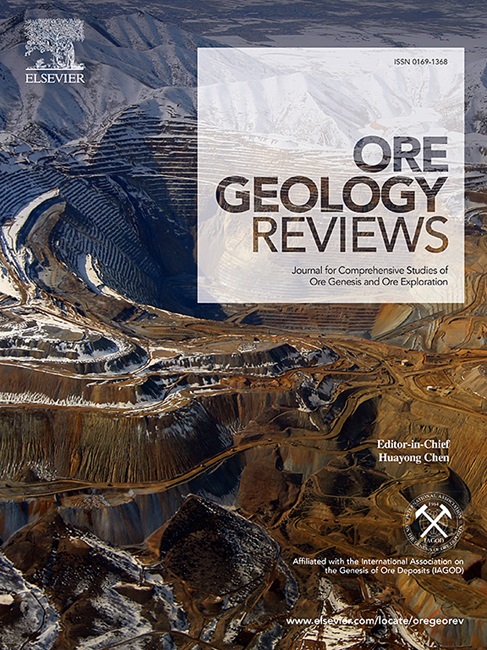利用硫铅同位素约束造山带含金矿脉流体来源——以苏格兰泰湖(Loch Tay)为例
IF 3.2
2区 地球科学
Q1 GEOLOGY
引用次数: 0
摘要
分离流体和金属来源以及矿化事件的数量可能具有挑战性,因为来自不同来源的流体混合在一起,可能会覆盖现有的矿化。地壳和/或盆地流体可能在“稀释”岩浆或地幔流体方面发挥作用,并可能对矿床中沉淀相的同位素组成产生重大影响,从而最终导致矿床类型的分类困难。我们提出了一个来自泰湖(苏格兰)南缘的这个问题的案例研究。硫、铅同位素研究结果表明,岩浆-热液作用是成矿系统形成的主要原因,但由于岩浆-热液与地壳流体的混合作用,这一特征在某些地区逐渐模糊。已经观察到两个独立的矿化事件的迹象,但区分第一阶段和第二阶段是具有挑战性的。我们的研究表明,需要了解矿物系统的特征和地质背景,以支持可靠的解释。研究结果对区域勘探模式也有启示意义:我们认为泰湖的大部分含金矿脉可能是岩浆成因,而不是“造山带金”类型。此外,Tay湖周围的矿脉提供了一个具有造山特征的矿脉型金矿化如何与岩浆作用相关的研究案例,这表明全球其他含金矿脉的同位素数据可能由于流体混合而被误解,特别是在对区域背景知之甚少的情况下。本文章由计算机程序翻译,如有差异,请以英文原文为准。

Constraining the fluid sources of gold-bearing veins in orogenic belts using sulfur and lead isotopes: A case study from Loch Tay, Scotland (UK)
Unpicking the fluid and metal sources, and the number of mineralizing events, can be challenging because fluids from different origins mix and can overprint existing mineralization. Crustal and/or basinal fluids may play a role in “diluting” magmatic or mantle fluids and can have a significant impact on the isotope composition of the precipitated phases in an ore deposit, which ultimately leads to difficulties in classifying the deposit style. We present a case study of this problem from the southern margin of Loch Tay (Scotland). The results from sulfur and lead isotope studies indicate that magmatic-hydrothermal processes were responsible for the establishment of the mineralizing system, but this signature gets progressively obscured in some localities due to mixing between magmatic-hydrothermal and crustal fluids. Indications of two separate mineralization events have been observed, but differentiating the first stage from the second one is challenging. Our study demonstrates the need to understand the characteristics of the mineral system and the geological setting to support robust interpretation. The results also have implications for regional exploration models: we suggest that the majority of the auriferous vein occurrences at Loch Tay are probably of a magmatic origin, rather than of an “orogenic gold” type. Furthermore, the veins around Loch Tay provide a case study of how vein-hosted gold mineralization with some orogenic characteristics may be related to magmatism, suggesting that isotope data from other auriferous veins globally may be misinterpreted due to fluid mixing, particularly if the regional context is poorly understood.
求助全文
通过发布文献求助,成功后即可免费获取论文全文。
去求助
来源期刊

Ore Geology Reviews
地学-地质学
CiteScore
6.50
自引率
27.30%
发文量
546
审稿时长
22.9 weeks
期刊介绍:
Ore Geology Reviews aims to familiarize all earth scientists with recent advances in a number of interconnected disciplines related to the study of, and search for, ore deposits. The reviews range from brief to longer contributions, but the journal preferentially publishes manuscripts that fill the niche between the commonly shorter journal articles and the comprehensive book coverages, and thus has a special appeal to many authors and readers.
 求助内容:
求助内容: 应助结果提醒方式:
应助结果提醒方式:


